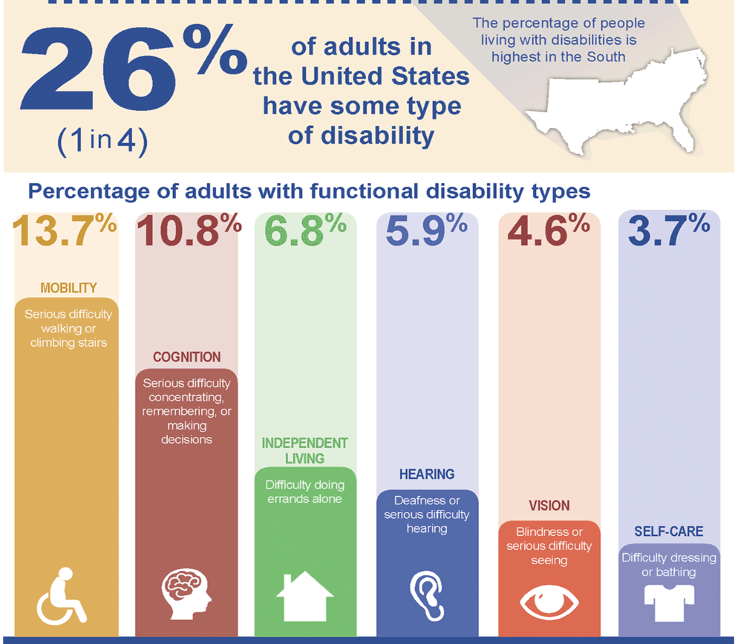WebAIM
‹ BackTable of Contents
What is WebAIM?
WebAIM Resources
Introduction to Accessible Design
The WAVE Tool
References
What is WebAIM?
WebAIM, short for Web Accessibility in mind, is a non-profit organization founded in 1999 and is based in Utah State University, in Logan, Utah. Their mission is to expand “the potential of the web for people with disabilities by empowering individuals and organizations to create accessible content” by providing the knowledge, technical skills, tools, organizational leadership strategies, and vision to empower organizations in making their content accessible to people with disabilities.
According to the Center for Disease Control and Prevention, one in four adults in the United States has a disability, which is almost 83 million people. Although not all disabilities impact internet use, it is imperative to design with all individuals in mind. For institutions of higher education and government agencies, failure to make online resources accessible may result in discrimination and eventual lawsuits.
The internet offers independence and freedom that is unavailable through any other medium. If businesses, organizations (private and public), federal agencies, institutions of higher education, K-12 institutions, and others ignore accessibility intentionally or unintentionally, they exclude a segment of the population that stands to gain the most from the internet and the web. Web accessibility ensures that the web, your website and your business are accessible to and can be used by a broader population.

WebAIM Resources
WebAIM has defined four different categories of disability and outlined a deliberate strategy for designing content for each. These categories are visual disabilities (e.g. blindness, low vision, or color blindness), motor disabilities (e.g. Parkinson’s disease, muscular dystrophy, or cerebral palsy), cognitive disabilities (e.g. dementia, autism, traumatic brain injury), and deafness or hearing impairments. Although designed to help individuals with disabilities, these strategies often promote universal access and inclusivity because everyone benefits when content includes helpful illustrations, navigation that is intuitive, content that is chunked into digestible pieces, videos that have captions, and audio that is supported with transcripts. If you are interested in reading more about how people with disabilities use the web, the W3C has compiled a repository for their stories that also includes some of the best techniques and tools available for them to use.
Introduction to Accessible Design
You may have noticed the interconnectedness and overlap of WCAG, W3C, and Section 508 principles; however, each of these serves a specific purpose. WebAIM’s mission in particular is to provide tools and resources to help web developers, designers, web masters and others who work in this area make the internet more accessible for everyone. Below you will find a list of some key principles of accessible web design. Most can be implemented without compromising the overall look and feel of your website. Please click on the links to read about these principles in greater detail.
- Provide equivalent alternative text: Alternative text is a textual alternative to non-text content, such as images, in web pages.
- Create logical document structure: Headings, lists, and other structural elements provide meaning and structure to web pages and facilitate keyboard navigation.
- Provide headers for data tables: Tables need to include row and column header cells programmatically associated with their corresponding data cells.
- Ensure users can complete and submit all forms: Every form element (text field, checkbox, dropdown list, etc.) should have programmatically associated label.
- Write links that make sense out of context: Descriptive phrases for all URLs and links provide more information to the reader about what that link. Avoid using phrases and words like “click here” or “more” and instead use phrases and verbiage that describe the links and the content.
- Caption and/or provide transcripts for media: Videos and live audio must have captions and a transcript. WebAIM suggests that for archived audio, a transcription may be enough.
- Ensure accessibility files and other non-HTML content: Files and other content must be as accessible as possible with alt-text for images, logical document structures, and chunking. If a document cannot be made accessible, consider using HTML instead or, at the very least, providing an accessible alternative.
- Allow users to skip repetitive elements on the page: Each page on your website should allow the user to skip navigation or other elements that repeat on every page.
- Do not rely on color alone to convey meaning: Although color can enhance comprehension through signaling, it cannot be used as the only tool to convey meaning.
- Make sure content is clearly written and easy to read: Simple, clear sentences (instead of complex, obtuse sentence structures), clean fonts, headings, and logical lists make web content easier to read and understand.
- Make JavaScript accessible: JavaScript event handlers should be device independent (i.e., they do not require the use of a mouse).
- Design to standards: Valid HTML and CSS promote accessibility by making code more flexible and robust.
The WAVE Tool
WebAIM also administers the WAVE accessibility tool, a suite of free evaluation tools that provide visual feedback about whether a web page is accessible. You can use the online WAVE tool to test the accessibility of a web page by entering the URL into the WAVE browser. You can also view their Introduction to the WAVE Tool video for more information about how it works.
-
References
W3C Web Accessibility Initiative (WAI). (2021). How people with disabilities use the web. W3C. https://www.w3.org/WAI/people-use-web/
WebAIM. (14 April 2020). Introduction to Web Accessibility. WebAIM. https://webaim.org/intro/
WebAIM. (2021). Resources. WebAIM. https://webaim.org/resources/
WebAIM. (2021). Visual disabilities: Color blindness. WebAIM. https://webaim.org/articles/visual/colorblind
Wikipedia. (2021). WebAIM. Wikipedia. https://en.wikipedia.org/wiki/WebAIM











